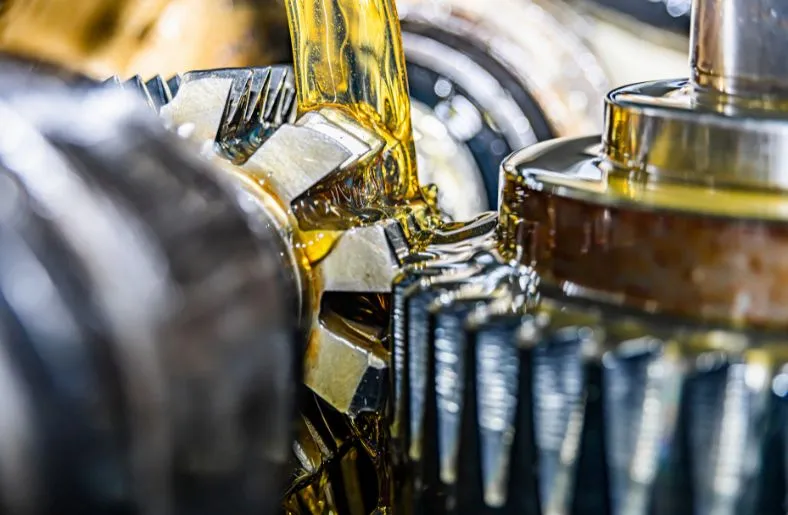In all types of machines, the surfaces of moving, sliding, or rolling parts rub against each other. Due to the mutual rubbing of one part against another, resistance is offered to their movement. This resistance is known as friction. It causes a lot of wear and tear on the surfaces of moving parts. Any substance introduced between two moving/sliding surfaces to reduce the friction (or frictional resistance) between them is known as a lubricant. The main purpose of a lubricant is to keep the moving/sliding surfaces apart so that friction and consequent destruction of material are minimized. The process of reducing friction between moving/sliding surfaces, by the introduction of lubricants in between them, is called lubrication.
Lubricants are the unsung heroes of the industrial world, silently ensuring the smooth operation of countless machines and engines. From the engines in your car to the complex machinery in manufacturing plants, lubricants play a crucial role in reducing friction, dissipating heat, and preventing wear and tear. To truly understand the world of lubricants, it’s essential to grasp the classification systems that help categorize these vital substances.
In this comprehensive guide, we shall explore the classification of lubricants, their different types, and the critical roles they play in various industries.
Table of Contents
The Science of Lubrication
The Fundamental Role of Lubricants
At its core, lubrication is the process of reducing friction between two surfaces in relative motion. Friction generates heat, causes wear and tear on moving parts, and can lead to decreased efficiency and eventual equipment failure. Lubricants serve as a protective barrier between these surfaces, allowing them to glide smoothly and reducing frictional forces.
Why Classification Matters
Classification systems for lubricants are essential because they help engineers and industries choose the right lubricant for specific applications. The choice of lubricant depends on factors like operating conditions, load-bearing capacity, and compatibility with materials. Understanding these classifications empowers professionals to make informed decisions about which lubricant best suits their needs.
Function of Lubricants
- It reduces wear and tear of the surfaces by avoiding direct metal-to-metal contact between the rubbing surfaces, i.e., by introducing lubricants between the two surfaces
- It reduces the expansion of metal due to frictional heat and destruction of material
- It acts as a coolant of metal due to heat transfer media
- it avoids unsmooth relative motion
- It reduces maintenance cost
- It also reduces power loss in internal combustion engines
Classification of Lubricants: An Overview
Lubricants are broadly classified into three categories based on their physical state: liquid, solid, and semi-solid. Each category offers unique properties and is suited to particular applications.
Liquid Lubricants
Lubricating oils are also known as liquid lubricants and are further classified into three categories; (a) Animal and Vegetable oils, (b) Mineral or Petroleum oils, and (c) blended oils.
Animal and Vegetable oils
Animal oils are extracted from crude fat and vegetable oils such as cotton seed oil and caster oils. These oils possess good oiliness and hence they can stick on metal surfaces effectively even under elevated temperatures and heavy loads. But they suffer from the disadvantages that they are costly, undergo easy oxidation to give gummy products and hydrolyze easily in contact with moist air or water. Hence, they are only rarely used these days for lubrication. However, they are still used as blending agents in petroleum-based lubricants to get improved oiliness.
Mineral or Petroleum oils
These are lower molecular weight hydrocarbons with about 12 to 50 carbon atoms. As they are cheap, available in abundance, and stable under service conditions, hence they are widely used. However the oiliness of mineral oils is less, so the addition of higher molecular weight compounds like oleic acid and stearic acid increases the oiliness of mineral oil.
Blended oils
No single oil possesses all the properties required for a good lubricant and hence the addition of proper additives is essential to make them perform well. Such additives added to lubricating oils are called blended oils. Examples: The addition of higher molecular weight compounds like oleic acid, stearic acid, palmitic acid, etc, or vegetable oil like coconut oil, castor oil, etc increases the oiliness of mineral oil.
Solid Lubricants
They are preferred where (1) the operating conditions are such that a lubricating film cannot be secured by the use of lubricating oils or grease (2) contamination (By the entry of dust particles) of lubricating oils or grease is unacceptable (3) the operating temperature or load is too high, even for grease to remain in position, and (4) combustible lubricants must be avoided. They are used either in the dry powder form or with binders to make them stick firmly to the metal surfaces while in use. They are available as dispersions in non-volatile carriers like soaps, fats, waxes, etc, and as soft metal films. The most common solid lubricants are graphite, molybdenum disulfide, tungsten disulfide, and zinc oxide.
They can withstand temperatures up to 650° C and can be applied in continuously operating situations. They are also used as additives to mineral oils and greases to increase the load-carrying capacity of the lubricant. Other solid lubricants in use are soapstone (talc) and mica.
Graphite
It is the most widely used of all the solid lubricants and can be used either in the powdered form or in suspension. It is soapy to touch; non-inflammable and stable up to a temperature of 375° C. Graphite has a flat plate-like structure and the layers of graphite sheets are arranged one above the other and held together by weak van Der Waal’s forces. These parallel layers which can easily slide one over the other make graphite an effective lubricant. Also, the layer of graphite tends to absorb oil and be wetted off it.
Molybdenum Disulphide
It has a sandwich-like structure with a layer of molybdenum atoms in between two layers of sulfur atoms. Poor interlaminar attraction helps these layers to Slide over one another easily. It is stable up to a temperature of 400° C.
Semi-Solid Lubricants
A semi-solid lubricant obtained by combining lubricating oil with thickening agents is termed grease. Lubricating oil is the principal component and it can be either petroleum oil or a synthetic hydrocarbon of low to high viscosity. The thickeners consist primarily of special soaps of Li, Na, Ca, Ba, Al, etc. Non-soap thickeners include carbon black, silica gel, polyurea, and other synthetic polymers, clays, etc. Grease can support a much heavier load at a lower speed.
The internal resistance of grease is much higher than that of lubricating oils; therefore, it is better to use oil instead of grease. Compared to lubricating oils, grease cannot effectively dissipate heat from the bearings, so works at a relatively lower temp.
Synthetic Lubricants
Synthetic lubricants are a combination of synthetic base oil plus thickeners and additives that will give the grease or oil lubricant several performance advantages over conventional mineral-based lubricants. Synthetic oil is a lubricant consisting of chemical compounds that are artificially made (synthesized). Synthetic lubricants can be manufactured using chemically modified petroleum components rather than whole crude oil, but can also be synthesized from other raw materials. Synthetic oil is used as a substitute for lubricant refined from petroleum when operating in extremes of temperature, because, in general, it provides superior mechanical and chemical properties to those found in traditional mineral oils.
Aircraft jet engines, for example, require the use of synthetic oils, whereas aircraft piston engines do not. Synthetic lubricants are also used in metal stamping to provide environmental and other benefits when compared to conventional petroleum and animal fat-based products. These products are also referred to as “non-oil” or “oil-free”.
Advantages
The technical advantages of synthetic motor oils include:
- Better low- and high-temperature viscosity performance at service temperature extremes
- Better (higher) Viscosity Index (VI)
- Better chemical and shear stability
- Decreased evaporative loss
- Resistance to oxidation, thermal breakdown, and oil sludge problems
- Possibility to extended drain intervals, with the environmental benefit of less used oil waste generated
- Improved fuel economy in certain engine configurations
- Better lubrication during extreme cold weather starts
- Possibly a longer engine life
- Superior protection against “ash” and other deposit formation in engine hot spots (in particular in turbochargers and superchargers) for less oil burn-off and reduced chances of damaging oil passageway clogging.
- Increased horsepower and torque due to less initial drag on the engine
- Improved Fuel Economy (FE) – from 1.8% to up to 5% has been documented in fleet tests
Disadvantages
The disadvantages of synthetic motor oils include:
- Substantially more expensive (per volume) than mineral oils.
- Potential decomposition problems in certain chemical environments (predominantly in industrial use.)
Types of Lubricants Within Each Classification
Liquid Lubricants: Oils and Fluids
Liquid lubricants encompass a wide range of oils and fluids. They are further categorized based on their composition, with examples like:
- Mineral Oils: Derived from petroleum, these are the most common types of lubricating oils.
- Synthetic Oils: Chemically engineered for superior performance, synthetic oils are highly resistant to temperature extremes and oxidation.
- Vegetable-Based Oils: Derived from renewable sources, these oils are chosen for their biodegradability and reduced environmental impact.
Solid Lubricants: From Graphite to MoS2
Solid lubricants, often used in extreme conditions, include:
- Graphite: Known for its excellent lubricating properties, especially in high-temperature and vacuum environments.
- Molybdenum Disulfide (MoS2): Effective in reducing friction and wear in demanding applications.
- Polytetrafluoroethylene (PTFE): Commonly recognized by the brand name Teflon, PTFE provides low-friction performance and is chemically inert.
Semi-Solid Lubricants: The World of Greases
Greases are named according to their thickener and base oil, and there are numerous types designed for specific applications, such as lithium complex grease, calcium sulfonate grease, and polyurea grease.
Related Guide: 5W-30 or 10W-30 for Winter Weather: Choosing the Right Motor Oil (2023-2024)
Choosing the Right Lubricant: Factors to Consider
Selecting the appropriate lubricant involves considering several factors:
Operating Conditions
Understanding the temperature range, load, and speed at which equipment operates is essential. Different lubricants perform optimally under specific conditions, whether it’s high-temperature industrial machinery or low-temperature refrigeration systems.
Equipment Requirements
Each machine or component may have unique lubrication requirements, and compatibility with materials is crucial. Some lubricants may interact adversely with certain metals or plastics, leading to equipment damage.
Environmental Impact
Environmental considerations are increasingly important, with a growing focus on biodegradable and environmentally friendly lubricants, particularly in industries where contamination is a concern.
Related Guide: How to Load a Grease Gun Without a Cartridge: A Step-by-Step Guide (2023)
Conclusion
In the intricate world of machinery and industry, lubricants silently work their magic, ensuring the smooth operation of critical components. Understanding the classification of lubricants and their types is valuable knowledge that empowers professionals to make informed choices, optimize equipment performance, and reduce maintenance costs.
These unsung heroes of industry play a pivotal role in keeping the world running smoothly, one well-lubricated machine at a time.

